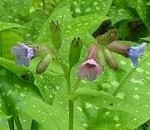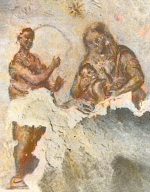
Also known as Bethelehem sage, Virgin Mary’s milkdrops and Mary’s milk sile, this herbaceous perennial is native to France and Italy and is member of the borage family, Borageacea, that also includes forget-me-not (Myosotis spp.) and Siberian bugloss (Brunnera macrophylla). Plants have a creeping rhizomatous rootstock up to 24″ wide, and form a basal rosette of leaves. The leaves are 4-12″ long leaves depending on the cultivar and are dark green with silver mottling and bristly hairs. The bell-shaped flowers are slightly nodding and produced in clusters on sparsely-leaved stems up to 18″ tall from April to May before the foliage has expanded. Each flower is one inch long and opens from pink buds so that both blue flowers and pink buds may be present in the same cluster at one time. Photo Credit Wikipedia

The common names of this plant, Virgin Mary’s milkdrops and Mary’s milk sile, suggest the image of Maria Lactans (nursing Madonna, with her tears forming the white mottling on the leaves of the plant. ) This image was very popular from early Christian times to about the 14th century when it was superseded by the image of the crucifixion. Possibly the earliest image of Mary nursing Jesus comes from the Catacomb of Priscilla on the Via Salaria in Rome that shows baby Jesus nursing on the lap of his mother (right). Over time many images of Maria Lactans were produced by artists including Lucas Cranach the Elder, Albrect Durer, and El Greco (below). There is no mention in the Bible of Mary nursing Jesus but since her options were limited it is a fair supposition. The only other possibility would have been a wet nurse but if there was such a woman in Jesus’ life some mention would probably have been made of her. Photo Credit Wikipedia

Common lungwort likes full to part shade and average, medium moist, well-drained soil and should not be allowed to dry out. It does not do well with the combination of heat and humidity. Plants self-seed, spread slowly by rhizomes, and can also be propagated by division. Plants can be damaged by root rot in poorly drained soil, powdery mildew, and slugs. Common lungwort is an excellent choice for moist shade and can be used as a ground cover. Several good cultivars are available that vary in flower color, leaf length and leaf markings. USDA Hardiness Zones 3-10
The generic name, Pulmonaria, comes from the Latin word pulmo meaning lung and refers to the fact that the leaves look like diseased lungs and were used to treat lung diseases in the past. This characteristic is also noted by the common name lungwort. The specific epithet is the Latin word saccharatus meaning sugary and refers to the white sugar like markings on the leaves.
Photo Credits Wikipedia